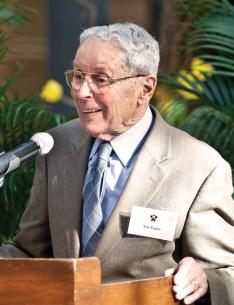
Of all the guests who attended the April 9 dedication of the Frick Chemistry Laboratory, there was none more honored than Edward C. “Ted” Taylor, the A. Barton Hepburn Professor of Organic Chemistry emeritus. The new building is truly the House that Taylor Built, since its $278 million construction cost was paid for by the University’s share of the royalties from the cancer drug Alimta.
“We are running out of ways to say ‘Thank you, Ted,’ ” said chemistry department chairman David MacMillan. “But we are nowhere near running out of thanks.”
In 1946, during graduate studies at Cornell, Taylor had found an intriguing journal article that described how scientists had isolated a compound from human liver that had the “totally unexpected property of being necessary for the growth of a number of microorganisms.” The compound’s two-ring core was almost identical to butterfly-wing pigments recently discovered. Taylor had found a dissertation topic.
But it was not until the mid-1970s that he returned to the compound and studied it for its potential use in chemotherapy. In the decades that followed, working closely with scientists at Eli Lilly, Taylor helped to develop Alimta.
At 87, Taylor has lost little of the energy or sparkle that endeared him to students since his arrival at Princeton in 1954. In introducing him at the building’s dedication, President Tilghman alluded to Alimta’s role in ensuring the chemistry department’s bright future, noting how “one discovery can beget a host of others.” She gave Taylor a big hug, and he stood beaming in the soaring common space that bears his name.

